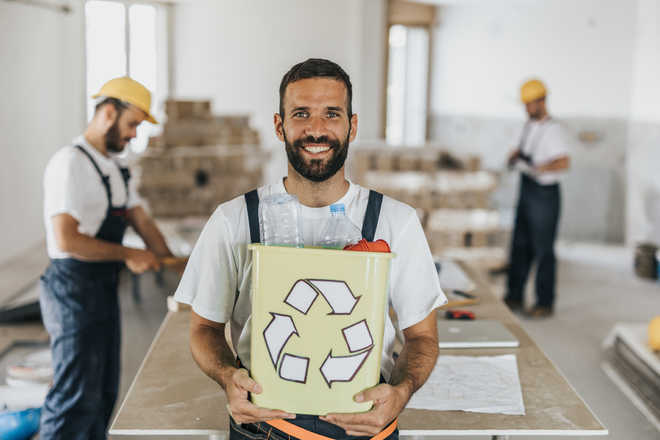
Pappal Suneja
Building materials are an integral part of the construction industry, thus in order to achieve the optimum balance between environment and our future aspirations; exploration of the under-explored building materials like bamboo, lime, fly ash concrete, marble waste as admixture, green concrete made by using recycled waste materials and waste plastic as concrete composite is important. Some such materials are:
Lime
Use of lime for wall and roof finishes in place of cement is beneficial especially for a developing nation like India as we are short of energy and lime manufacture uses almost no energy. Both cement & lime are made from calcium compound found in limestone and shells. These, if burnt in a kiln with a handful of charcoal as fuel to start the burning process, results in lime after getting cooled whereas cement is also made from same ingredients, including some other admixtures but it requires a lot of fuel in its processing. The ultimate strength of the mortar, however, is the same for both cement and lime. The cost of lime is Rs 150/50kg bag in comparison to Rs 400/50 kg bag of cement.
Fly Ash Concrete
Fly ash generated in power stations in India is light grey in colour and has the appearance of cement powder. It is a very fine powder which pollutes air and water and causes respiratory problems. Thus, use of fly ash concrete in place of plain cement concrete will not only enable substantial savings in the consumption of cement and energy but also clear air pollution.
The optimal use of fly ash in concrete has many technical advantages. It improves the performance of concrete. In the green (fresh) state, fly ash improves the workability of concrete and in the hardened state, and the strength and durability of concrete are improved.
Waste plastic as concrete composite
Plastic is a material that is manufactured for diverse applications and for various household items like plastic glasses, bottles, mugs, plastic furniture, plastic utensils and plastic auto parts etc. This cheap flexible and strong material is unfortunately non-biodegradable waste material whose disposal is becoming a threat globally.
Plastics can be majorly divided into two types: thermoplastic and thermosetting plastics. The thermoplastic can be melted for recycling in the plastic industry. But, the other type thermosetting plastic cannot be melted by heating. At present, these plastic wastes are disposed by either burning or burying, which are costly processes. Rebeiz (1996) studied the strength properties of unreinforced and reinforced polymer concrete using resins based recycled thermoplastic waste. He concluded that resin based recycled thermoplastic waste can be used to make a good quality of precast concrete. This is a cost effective as well as an eco-friendly approach as the plastic waste cost is negligible in comparison with other materials used as concrete composite.
Marble Waste as Admixture
Marble is commonly used as flooring and cladding material. However, disposal of the waste consisting of very fine powders from the marble industry is again a serious environmental problem. These waste materials can be effectively and economically used as admixtures which improve certain properties of plastic and hardened mortar and concrete. The cost of marble waste is negligible in comparison to other chemical admixtures.
The choice of building material makes a huge difference in our approach towards construction activities. The contextual response to understand the site requirements and conceive spaces while bringing in versatility with the use of unexplored sustainable building materials could be the simplest way to not only save on embodied energy nut also think to reduce energy consumption as far as its operational cost is concerned. Hence, our motto should be to adopt the use of regional, technological, economic and social implications while considering the use of materials for construction.
— The writer is an architect based in Ooty
Bamboo
Bamboo is an aesthetically beautiful material, that can be used extensively for lattice windows, pavilions, railings, partitions, wall paneling, false ceiling, furniture and lighting fixtures etc. Also, as it has a little more tensile strength than that of steel; it can be efficiently used to cast slab or foundation with bamboo reinforcement. The only trouble comes when the durability of the same is under consideration, as without adequate treatment bamboo construction shall not last more than 10-15 years because of attack from white ants. So, it is advisable to treat it with natural reagents like borax and boric acid. Further, since the outer layer of bamboo is 100 per cent water proof; for the above treatment to be successful, one should draw holes through and through nodes of the bamboo. There are a lot of bamboo varieties available in our country, so it is widely available in abundance for ground experimentations. The cost of treated bamboo is comparable to manufactured steel and wood, but it is environmentally sustainable.
Green concrete
The concrete made with eco-friendly wastes is called green concrete. It is economical to produce because waste materials are utilised as a partial replacement for cement reducing the expenditure involved in the disposal of wastes and better durability. Diverse by-product materials like ash, quarry dust, marble powder, demolished concrete, and rubble masonry are used in the making this concrete. The increased use of alternative raw materials helps in the low-energy consumption. The cost effectiveness is not only the main motivation of using pozzolanic wastes but to improve certain properties of concrete, mainly durability and to improve the environmental responsiveness of concrete, are the other reasons which make it suitable as a 'Green Building' material. The cost of customised green concrete on special demand is approximately Rs 4500/Cubic meter in comparison to Rs 7000/Cubic meter normal cement concrete.


























